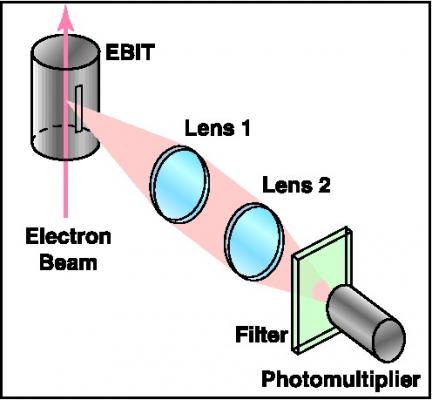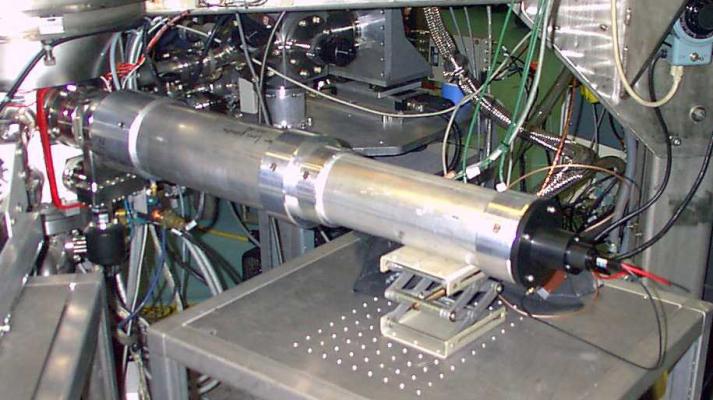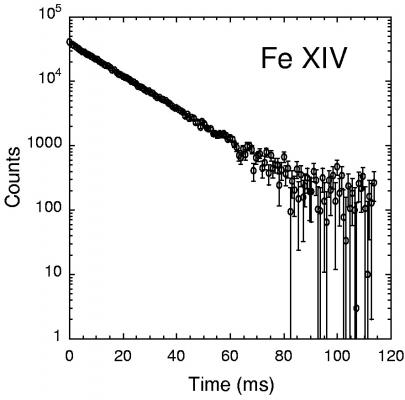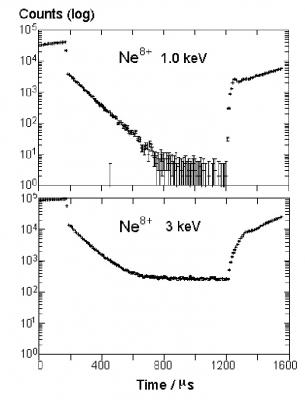Collisional-radiative models provide synthetic spectra of atoms and ions under specific environmental conditions such as density or temperature. The simulations involve atomic structure calculations of thousands of levels and tens of thousands of radiative transitions and other processes. Only a small fraction of the atomic data can in practice be verified by experiment. However, among these are the electric-dipole forbidden transition rates between levels of the ground configuration of many multiply charged ions. The radiative transition rates are comparable to collision rates in plasmas of various densities, and the competition between collisions and radiative decay influences the pattern of line intensities in many spectra. Observations of the relative line intensities in a terrestrial or astrophysical plasma can then be interpreted towards electron density and temperature of the plasma. The atomic level lifetimes of interest that we measure at EBIT range from less than a microsecond to many milliseconds.
For ions with many electrons, lifetime results with a precison of about one percent serve to benchmark calculations that often are uncertain by ten to twenty percent. This is quite adequate for all practical purposes in plasma and astrophysics. In ions with only a few electrons, theory is much more accurate. There measurements and calculations compete at uncertainties well below one percent. At present, the lifetime measurements of highest accuracy are in conflict with theory, which comprises highly developed quantum mechanics as well as QED corrections for both energy levels and the magnetic dipole transition operator. If confirmed, this would be a new way to possibly indicate New Physics beyond the Standard Model.
Our investigations of ions with long-lived excited states encompass the:
- Production of specific ion species inside the electron beam ion trap
- Spectroscopy (visible light, EUV, soft-x-ray) with links to astrophysics and plasma diagnostics
- Identification of long-lived ion species that are of particular interest in plasma diagnostic applications
- Accurate determination of transition rates, testing atomic structure calculations as well as the conditions inside the electron beam ion trap
- Most of the time-resolved x-ray measurements have used an IGLET-type solid state detector. Lifetimes in the range from microseconds to milliseconds have been studied using this option.
Time resolved measurements in the visible employ the "stovepipe" device and a low-noise photomultiplier. This detection system has been used for lifetime measurements in the millisecond range.
Time resolved observations in the EUV / soft-x-ray range and x-ray ranges are feasible with the XRS microcalorimeter, for timing features with millisecond lifetimes and above. After the M3 decay in Ni-like ions was demonstrated with this instrument, and line blends shown not to interfere, a better statistics experiment used a gas-and-wire x-ray detector.
The "stovepipe" instrument for optical observations
When the electron beam in the EBIT is switched on, ions of a given charge state are produced and then radiate (increasing part of the excitation curve). When the electron beam is switched off, excitation ends, but the ions remain trapped ("magnetic trapping mode" as in a Penning ion trap) and continue to emit light. The decay time constant can be extracted after subtraction of the background signal from the excitation curve, and it then reveals the upper level lifetime (after correction for ion losses from the trap).
Examples of data obtained with the "stovepipe" instrument
Examples of data obtained with the x-ray detector
In these measurements, the electron beam has been switched off from t=0.18 ms to t=1.2 ms. When the electron beam energy lies just above the production threshold for Ne8+ ions (say, at 1 keV), a clean single-exponential decay curve is being observed.With an electron beam energy set well above the production threshold of the He-like ion, a higher electron beam current can be used, maximizing the x-ray signal. Under these conditions the decay curve shows a tail that relates to the recombination of more highly charged Ne ions. This also causes a systematic error in the lifetime data evaluation.
| Isolectronic sequence | Ion | Level | Lifetime | Observation | Reference |
|---|---|---|---|---|---|
| He I | N5+ | 1s2s 3S1 | 3.93±0.05 ms | X ray | 5 |
| O6+ | 956±5 µs | X ray | 2 | ||
| F7+ | 276±2 µs | X ray | 5 | ||
| Ne8+ | 91.7±0.4 µs | X ray | 3 | ||
| Mg10+ | 13.61±0.49 µs | X ray | 1 | ||
| S14+ | 703±4 ns | X ray | 12 | ||
| Be I | Ar14+ | 2s2p 3Po2 | 15.0±0.8 ms | vis | 6 |
| K15+ | 7.65±0.50 ms | vis | 7 | ||
| B I | Cl12+ | 2s22p 2Po3/2 | 21.0±0.5 ms | vis | 9 |
| Ar13+ | 9.30±0.12 ms | vis | 6 | ||
| K14+ | 4.43±0.10 ms | vis | 7 | ||
| F I | Ar9+ | 2s22p52Po1/2 | 9.70±0.15 ms | vis | 6 |
| K10+ | 4.46±0.10 ms | vis | 7 | ||
| Ne I | Fe16+ | 2s22p53s 3Po2 | 4.91+0.23-0.08 µs | X ray | 14 |
| Al I | Fe13+ | 3s23p 2Po3/2 | 16.74±0.12 ms | vis | 10 |
| Si I | Kr22+ | 3s23p23P2 | 6.82±0.10 ms | uv | 4 |
| P I | Kr21+ | 3s23p32Do5/2 | 0.80±0.03 ms | uv | 8 |
| Ar I | Kr18+ | 3s23p53d 3Po2 | 2.3±0.1 ms | vis | 8 |
| Kr18+ | 3s23p53d 3Fo2 | 4.2±0.5 ms | vis | 8 | |
| K I | Kr17+ | 3s23p63d 2D5/2 | 22.7±1.0 ms | vis | 8 |
| Ca I | Kr16+ | 3s23p63d23P2 | approx. 4.2 ms | vis | 8 |
| Ni I | Xe26+ (nat. isotope mix) | 3d94s 3D3 | 11.5±0.5 ms | XUV | 11 |
| 132Xe26+ | 3d94s 3D3 | 15.06±0.24 ms | XUV | 13 | |
| 129Xe26+ | 3d94s 3D3 (F=7/2) | 15.1±0.5 ms | XUV | 13 | |
| 129Xe26+ | 3d94s 3D3 (F=5/2) | 2.7±0.1 ms | XUV | 13 | |
| Cs27+ | 3d94s 3D3 | 8.2±2 ms | XUV | 11 | |
| Ba28+ | 3d94s 3D3 | 4.3±3.6 ms | XUV | 11 |
| Isolectronic sequence | Ion | Level | Lifetime | Observation | Laboratory |
|---|---|---|---|---|---|
| Be I | Ar14+ | 2s2p 3Po2 | 15.0±0.7 ms | vis | Oxford EBIT (1998) |
| B I | Ar13+ | 2s22p 2Po3/2 | 8.7±0.5 ms | vis | NIST EBIT (1998) |
| 9.597±0.021 ms | vis | Heidelberg EBIT (2004) | |||
| 9.573(4)(5) ms | vis | Heidelberg EBIT (2005) | |||
| Al I | Fe13+ | 3s23p 2Po3/2 | 16.726+0.020-0.010 ms | vis | Heidelberg EBIT (2007) |
| Si I | Kr22+ | 3s23p23P2 | 5.7±0.5 ms | uv | NIST EBIT (1998) |
| Cl I | Fe9+ | 3s23p52Po1/2 | 14.2±0.2 ms | vis | Heidelberg EBIT (2009) |
| Ti I | Xe32+ | 3d43p35D3 | 2.15±0.14 ms | uv | NIST EBIT (1997) |
References
- G. S. Stefanelli, P. Beiersdorfer, V. Decaux, K. Widmann, Phys. Rev. A 52, 3651 (1995)
- J. R. Crespo López-Urrutia, P. Beiersdorfer, D. W. Savin, K. Widmann, Phys. Rev. A 57, 238 (1998)
- E. Träbert, P. Beiersdorfer, G. V. Brown, A. J. Smith, S. B. Utter, M. F. Gu, D. W. Savin, Phys. Rev. A 60, 2034 (1999)
- E. Träbert, S. B. Utter, P. Beiersdorfer, Phys. Lett. A 272, 86 (2000)
- P. A. Neill, E. Träbert, P. Beiersdorfer, G. V. Brown, C. L. Harris, A. J. Smith, S. B. Utter, K. L. Wong, Physica Scripta 62, 141 (2000)
- E. Träbert, P. Beiersdorfer, S. B. Utter, G. V. Brown, H. Chen, C. L. Harris, P. A. Neill, D. W. Savin, A. J. Smith, Astrophys. J. 541 (1), 506 (2000)
- E. Träbert, P. Beiersdorfer, G. V. Brown, H. Chen, C. L. Harris, E. H. Pinnington, D. B. Thorn, Phys. Rev. A 64, 034501 (2001)
- E. Träbert, P. Beiersdorfer, G. V. Brown, H. Chen, D. B. Thorn, E. Biémont, Phys. Rev. A 64, 042511 (2001)
- E. Träbert, P. Beiersdorfer, G. Gwinner, E. H. Pinnington, A. Wolf, Phys. Rev. A 66, 052507 (2002)
- P. Beiersdorfer, E. Träbert, E. H. Pinnington, Astrophys. J. 587, 836 (2003)
- E. Träbert, P. Beiersdorfer, G. V. Brown, K. R. Boyce, R. L. Kelley, C. A. Kilbourne, F. S. Porter, A. Szymkowiak, Phys. Rev. A 73, 022508 (2006)
- J. R. Crespo López-Urrutia, P. Beiersdorfer, K. Widmann, Phys. Rev. A 74, 012507 (2006)
- E. Träbert, P. Beiersdorfer, G. V. Brown, Phys. Rev. Lett. 98, 263001 (2007)
- J. R. Crespo López-Urrutia, P. Beiersdorfer, Astrophys. J. 721, 576 (2010)
Additional reviews cover more measurements of such long atomic level lifetimes, using a variety of ion trap types, and give references to the physics context.
- E. Träert, Physica Scripta 61, 257 (2000)
- E. Träert, Physica Scripta T 100, 88 (2002)
- E. Träert, Can. J. Phys. 80, 1481 (2002)
- Talk at 20 Years of Spectroscopy at EBIT meeting, Berkeley (11/2007) (PDF)
There are corresponding Lifetime measurements at the Heidelberg heavy-ion storage ring TSR.









